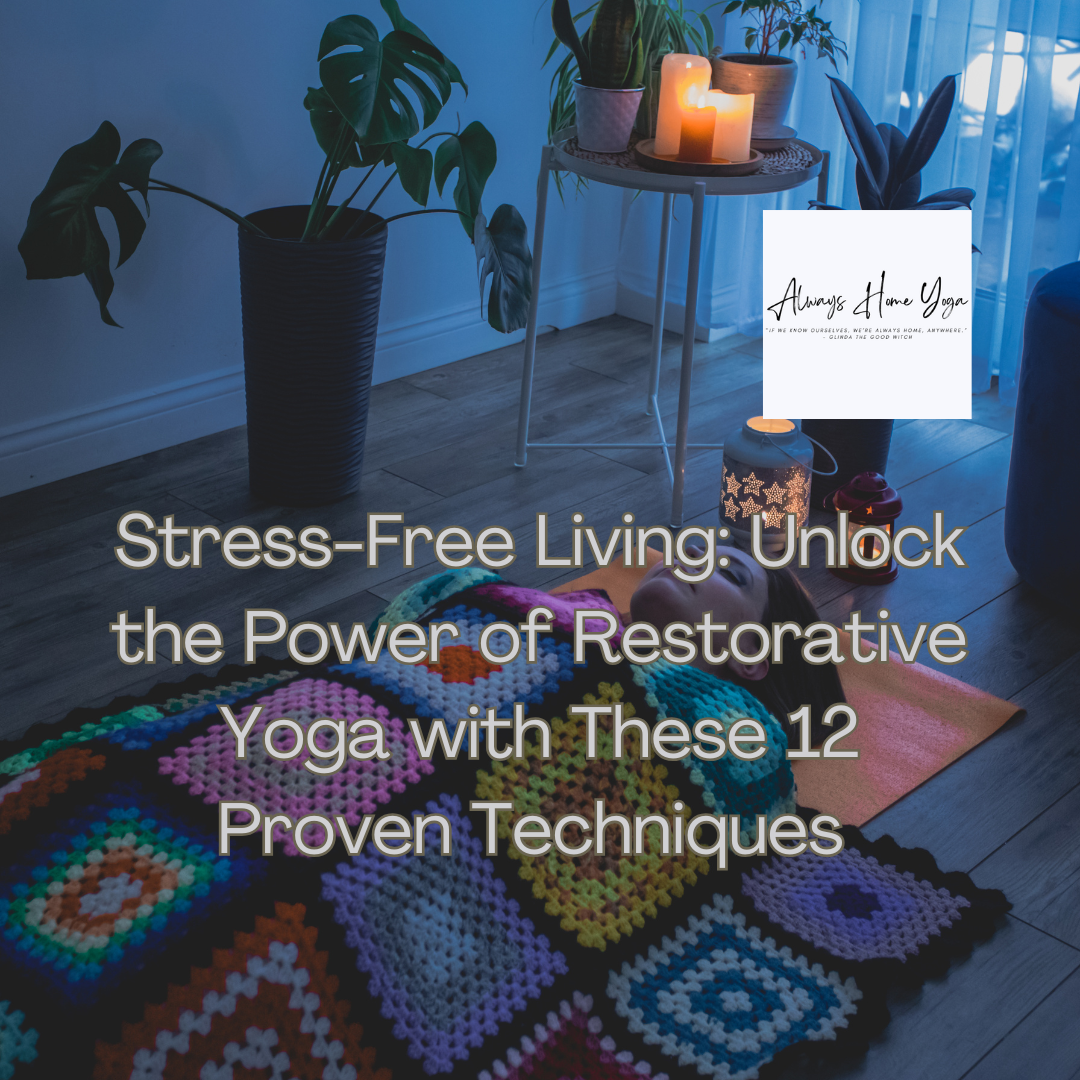This blog post will explore 12 proven restorative yoga techniques. They can help you manage stress and find a
more peaceful, balanced mind.
1. Start with Breath Awareness
One of the simplest yet most powerful ways to relieve stress is by focusing on your breath. In restorative yoga, breathing is the foundation of relaxation .
- How to Practice: Close your eyes. Take slow, deep breaths. Inhale through your nose. Exhale through your mouth. Focus on the sensation of your breath as it moves in and out of your body.
- Benefits: Breath awareness calms the mind, eases anxiety, and grounds you.
2. Use Props for Full Support
Restorative yoga uses props like blankets, bolsters, and blocks. They support your body in each pose. This allows you to relax completely without straining.
- How to Practice: Use pillows or bolsters under your knees, back, or head. This will fully support you in reclining or seated poses.
- Benefits: Full support for your body reduces muscle tension. It also helps you relax more deeply.
3. Try Legs Up the Wall (Viparita Karani)
This pose is a favorite, stress-relieving cure. It calms the nervous system and reduces fatigue.
- How to Practice: Lie on your back with your legs resting up against a wall. Adjust a bolster or folded blanket under your hips for extra support.
- Benefits: This pose boosts circulation, relaxes the lower back, and calms the body and mind.
4. Practice Body Scan Meditation
A body scan meditation helps you find and release tension.
- How to Practice: While lying in Savasana (Corpse Pose), mentally scan your body from head to toe. As you focus on each part, breathe deeply and visualize tension melting away.
- Benefits: This technique boosts mind-body awareness and reduces muscle tightness. It helps you connect more deeply with your body.
5. Hold Poses for Longer Periods
In restorative yoga, poses are often held for 5-15 minutes, giving your body plenty of time to unwind.
- How to Practice: Set a timer and allow yourself to relax fully into each pose without rushing. The longer holds give your body and mind time to soften and release.
- Benefits: Longer holds lead to deeper relaxation and less stress. They also improve mental clarity.
6. Incorporate Mindful Breathing (Pranayama)
Using pranayama, or mindful breathing, can boost the stress relief of restorative yoga.
- How to Practice: Try 4-7-8 breathing—inhale for 4 counts, hold for 7 counts, and exhale for 8 counts. This technique activates the parasympathetic nervous system. It controls rest and relaxation.
- Benefits: Mindful breathing reduces anxiety, lowers blood pressure, and calms the mind. It promotes focus.
7. Child’s Pose (Balasana) for Grounding
Child’s Pose is a gentle forward bend. It soothes the nervous system and grounds the mind.
- How to Practice: Kneel on the floor. Sit back on your heels. Extend your arms forward and lower your forehead to the mat. Use a bolster or blanket for additional support under your torso.
- Benefits: This pose releases tension in the back, shoulders, and hips. It provides physical and emotional comfort.
8. Use a Mantra or Affirmation
During your practice, repeat a calming mantra or affirmation. It can help quiet your mind and promote relaxation.
- How to Practice: While in a restorative pose, silently repeat a phrase like, “I am at peace” or “I release all tension.” Sync the repetition with your breath.
- Benefits: Positive affirmations can reframe stressful thoughts and create a soothing mental environment.
9. Supported Bridge Pose (Setu Bandhasana)
This pose gently opens the chest and relaxes the lower body, helping to alleviate stress.
- How to Practice: Lie on your back and place a bolster or block under your lower back for support. Let your arms rest by your sides or overhead.
- Benefits: This pose stretches the chest, improves breathing, and calms the mind. It relieves tension in the body’s core.
10. Create a Calming Environment
The setting for your practice plays a big role in helping you relax.
- How to Practice: Dim the lights, use essential oils like lavender, and play soft, relaxing music. Creating a tranquil space helps signal to your mind and body that it’s time to unwind.
- Benefits: A calming environment helps you relax. It deepens your yoga practice.
11. Savasana (Corpse Pose) for Complete Relaxation
Savasana is the ultimate pose for letting go. It’s often done at the end of a restorative yoga session. It helps to integrate all the benefits of your practice.
- How to Practice: Lie flat on your back with arms and legs extended. Support your neck, back, and knees with props for maximum comfort. Close your eyes and focus on your breath.
- Benefits: Savasana relaxes the entire body, relieves stress, and promotes emotional healing. It helps shift the body from “fight-or-flight” mode into “rest-and-digest.”
12. End with Gratitude
A practice of gratitude can greatly enhance your sense of peace and contentment.
- How to Practice: After your session, take a few moments to reflect on something you’re grateful for. It can be your body, your breath, or the time you’ve given yourself to relax.
- Benefits: Practicing gratitude shifts your focus from stress to positivity. It boosts your well-being.
Conclusion
Using these 12 restorative yoga techniques can transform your life. They can relieve stress. Restorative yoga provides a safe, nurturing space. It helps release tension, clear the mind, and find balance in body and spirit. These techniques will help you. They will unlock restorative yoga. You’ll then find calm and ease, whether you want to cope with stress or seek deeper healing.
Prioritizing relaxation and mindful movement can relieve stress. It can also boost your well-being. Start small, be patient. Sometimes, the best way to move forward is to slow down and breathe.

